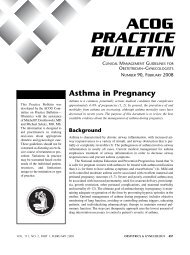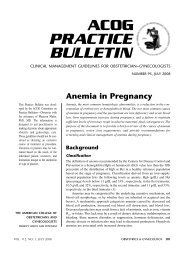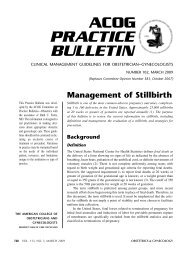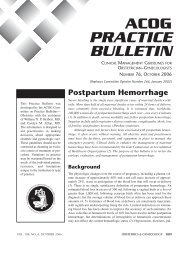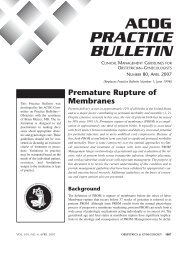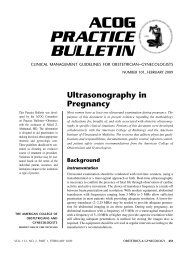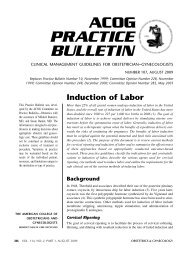10. Clark SL, Hankins GD. Temporal and demographic trendsin cerebral palsy—fact and fiction. Am J Obstet Gynecol2003;188:628–33. (Level III)11. Hankins GD, Speer M. Defining the pathogenesis andpathophysiology of neonatal encephalopathy and cerebralpalsy. Obstet Gynecol 2003;102:628–36. (Level III)12. Badawi N, Kurinczuk JJ, Keogh JM, Alessandri LM,O’Sullivan F, Burton PR, et al. Antepartum risk factors fornewborn encephalopathy: the Western Australian casecontrolstudy. BMJ 1998;317:1549–53. (Level II-2)13. Morrison JC, Chez BF, Davis ID, Martin RW, RobertsWE, Martin JN Jr, et al. <strong>Intrapartum</strong> fetal heart <strong>rate</strong>assessment: monitoring by auscultation or electronicmeans. Am J Obstet Gynecol 1993;168:63–6. (Level III)14. Vintzileos AM, Nochimson DJ, Antsaklis A, Varvarigos I,Guzman ER, Knuppel RA. Comparison of intrapartumelectronic fetal heart <strong>rate</strong> monitoring versus intermittentauscultation in detecting fetal acidemia at birth. Am JObstet Gynecol 1995;173:1021–4. (Level II-1)15. Nielsen PV, Stigsby B, Nickelsen C, Nim J. Intra- andinter-observer variability in the assessment of intrapartumcardiotocograms. Acta Obstet Gynecol Scand 1987;66:421–4. (Level III)16. Beaulieu MD, Fabia J, Leduc B, Brisson J, Bastide A,Blouin D, et al. The reproducibility of intrapartum cardiotocogramassessments. Can Med Assoc J 1982;127:214–6. (Level III)17. Blix E, Sviggum O, Koss KS, Oian P. Inter-observer variationin assessment of 845 labour admission tests: comparisonbetween midwives and obstetricians in the clinicalsetting and two experts. BJOG 2003;110:1–5. (Level III)18. Zain HA, Wright JW, Parrish GE, Diehl SJ. Interpretingthe fetal heart <strong>rate</strong> tracing. Effect of knowledge of neonataloutcome. J Reprod Med 1998;43:367–70. (Level III)19. Ayoubi JM, Audibert F, Vial M, Pons JC, Taylor S,Frydman R. <strong>Fetal</strong> heart <strong>rate</strong> and survival of the very prematurenewborn. Am J Obstet Gynecol 2002;187:1026–30. (Level II-2)20. Westgren M, Holmquist P, Svenningsen NW, IngemarssonI. <strong>Intrapartum</strong> fetal monitoring in preterm deliveries:prospective study. Obstet Gynecol 1982;60:99–106.(Level II-2)21. Westgren M, Hormquist P, Ingemarsson I, Svenningsen N.<strong>Intrapartum</strong> fetal acidosis in preterm infants: fetal monitoringand long-term morbidity. Obstet Gynecol 1984;63:355–9. (Level II-2)22. Hill JB, Alexander JM, Sharma SK, McIntire DD, LevenoKJ. A comparison of the effects of epidural and meperidineanalgesia during labor on fetal heart <strong>rate</strong>. ObstetGynecol 2003;102:333–7. (Level I)23. Lieberman E, O’Donoghue C. Unintended effects ofepidural analgesia during labor: a systematic review. AmJ Obstet Gynecol 2002;186(suppl 1):S31–68. (Level III)24. Gambling DR, Sharma SK, Ramin SM, Lucas MJ,Leveno KJ, Wiley J, et al. A randomized study of combinedspinal-epidural analgesia versus intravenousmeperidine during labor: impact on cesarean delivery <strong>rate</strong>.Anesthesiology 1998;89:1336–44. (Level I)25. Abrao KC, Francisco RP, Miyadahira S, Cicarelli DD,Zugaib M. Elevation of uterine basal tone and fetal heart<strong>rate</strong> abnormalities after labor analgesia: a randomizedcontrolled trial. Obstet Gynecol 2009;113:41–7. (Level I)26. Wright JW, Ridgway LE, Wright BD, Covington DL,Bobitt JR. Effect of MgSO4 on heart <strong>rate</strong> monitoring inthe preterm fetus. J Reprod Med 1996;41:605–8. (LevelII-2)27. Hatjis CG, Meis PJ. Sinusoidal fetal heart <strong>rate</strong> patternassociated with butorphanol administration. ObstetGynecol 1986;67:377–80. (Level II-2)28. Chazotte C, Forman L, Gandhi J. <strong>Heart</strong> <strong>rate</strong> patterns infetuses exposed to cocaine. Obstet Gynecol 1991;78:323–5. (Level II-3)29. Giannina G, Guzman ER, Lai YL, Lake MF, Cernadas M,Vintzileos AM. Comparison of the effects of meperidineand nalbuphine on intrapartum fetal heart <strong>rate</strong> tracings.Obstet Gynecol 1995;86:441–5. (Level I)30. Kopecky EA, Ryan ML, Barrett JF, Seaward PG, Ryan G,Koren G, et al. <strong>Fetal</strong> response to maternally administeredmorphine. Am J Obstet Gynecol 2000;183:424–30.(Level II-2)31. Ville Y, Vincent Y, Tordjman N, Hue MV, Fernandez H,Frydman R. Effect of betamethasone on the fetal heart<strong>rate</strong> pattern assessed by computerized cardiotocographyin normal twin pregnancies. <strong>Fetal</strong> Diagn Ther 1995;10:301–6. (Level II-3)32. Subtil D, Tiberghien P, Devos P, Therby D, Leclerc G,Vaast P, et al. Immediate and delayed effects of antenatalcorticosteroids on fetal heart <strong>rate</strong>: a randomized trial thatcompares betamethasone acetate and phosphate,betamethasone phosphate, and dexamethasone. Am JObstet Gynecol 2003;188:524–31. (Level I)33. Senat MV, Minoui S, Multon O, Fernandez H, FrydmanR, Ville Y. Effect of dexamethasone and betamethasone onfetal heart <strong>rate</strong> variability in preterm labour: a randomisedstudy. Br J Obstet Gynaecol 1998;105:749–55. (Level I)34. Parer JT, King T, Flanders S, Fox M, Kilpatrick SJ. <strong>Fetal</strong>acidemia and electronic fetal heart <strong>rate</strong> patterns: is thereevidence of an association? J Matern <strong>Fetal</strong> Neonatal Med2006;19:289–94. (Level III)35. Williams KP, Galerneau F. <strong>Intrapartum</strong> fetal heart <strong>rate</strong>patterns in the prediction of neonatal acidemia. Am JObstet Gynecol 2003;188:820–3. (Level II-3)36. Samueloff A, Langer O, Berkus M, Field N, Xenakis E,Ridgway L. Is fetal heart <strong>rate</strong> variability a good predictorof fetal outcome? Acta Obstet Gynecol Scand 1994;73:39–44. (Level II-2)37. Skupski DW, Rosenberg CR, Eglinton GS. <strong>Intrapartum</strong>fetal stimulation tests: a meta-analysis. Obstet Gynecol2002;99:129–34. (Meta-analysis)38. Goodwin TM, Milner-Masterson L, Paul RH. Eliminationof fetal scalp blood sampling on a large clinical service.Obstet Gynecol 1994;83:971–4. (Level II-3)39. Hendrix NW, Chauhan SP, Scardo JA, Ellings JM, DevoeLD. Managing nonreassuring fetal heart <strong>rate</strong> patternsbefore cesarean delivery. Compliance with <strong>ACOG</strong> recommendations.J Reprod Med 2000;45:995–9. (Level III)VOL. 114, NO. 1, JULY 2009 <strong>ACOG</strong> <strong>Practice</strong> <strong>Bulletin</strong> <strong>Intrapartum</strong> <strong>Fetal</strong> <strong>Heart</strong> Rate <strong>Monitoring</strong> 201
40. Kruger K, Hallberg B, Blennow M, Kublickas M,Westgren M. Predictive value of fetal scalp blood lactateconcentration and pH as markers of neurologic disability.Am J Obstet Gynecol 1999;181:1072–8. (Level II-3)41. Wiberg-Itzel E, Lipponer C, Norman M, Herbst A,Prebensen D, Hansson A, et al. Determination of pH orlactate in fetal scalp blood in management of intrapartumfetal distress: randomised controlled multicentre trial.BMJ 2008;336:1284–7. (Level I)42. Garite TJ, Dildy GA, McNamara H, Nageotte MP, BoehmFH, Dellinger EH, et al. A multicenter controlled trial offetal pulse oximetry in the intrapartum management ofnonreassuring fetal heart <strong>rate</strong> patterns. Am J ObstetGynecol 2000;183:1049–58. (Level I)43. Bloom SL, Spong CY, Thom E, Varner MW, Rouse DJ,Weininger S, et al. <strong>Fetal</strong> pulse oximetry and cesareandelivery. National Institute of Child Health and HumanDevelopment Maternal-<strong>Fetal</strong> Medicine Units Network. NEngl J Med 2006;355:2195–202. (Level I)44. East CE, Chan FY, Colditz PB, Begg L. <strong>Fetal</strong> pulseoximetry for fetal assessment in labour. CochraneDatabase of Systematic Reviews 2007, Issue 2. Art.No.: CD004075. DOI: 10.1002/14651858.CD004075.pub3. (Meta-analysis)45. Kulier R, Hofmeyr GJ. Tocolytics for suspected intrapartumfetal distress. Cochrane Database of SystematicReviews 1998, Issue 2. Art. No.: CD000035. DOI: 10.1002/14651858.CD000035. (Meta-analysis)46. Egarter CH, Husslein PW, Rayburn WF. Uterine hyperstimulationafter low-dose prostaglandin E2 therapy:tocolytic treatment in 181 cases. Am J Obstet Gynecol1990;163:794–6. (Level II-2)47. Miyazaki FS, Taylor NA. Saline amnioinfusion for reliefof variable or prolonged decelerations. A preliminaryreport. Am J Obstet Gynecol 1983;146:670–8. (Level III)48. Hofmeyr GJ. Amnioinfusion for potential or suspectedumbilical cord compression in labour. Cochrane Databaseof Systematic Reviews 1998, Issue 1. Art. No.: CD000013.DOI: 10.1002/14651858.CD000013. (Meta-analysis)49. Rinehart BK, Terrone DA, Barrow JH, Isler CM,Barrilleaux PS, Roberts WE. Randomized trial of intermittentor continuous amnioinfusion for variable decelerations.Obstet Gynecol 2000;96:571–4. (Level I)The MEDLINE database, the Cochrane Library, and<strong>ACOG</strong>’s own internal resources and documents were usedto conduct a literature search to locate relevant articles publishedbetween January 1985 and January 2009. The searchwas restricted to articles published in the English language.Priority was given to articles reporting results of original research,although review articles and commentaries alsowere consulted. Abstracts of research presented at symposiaand scientific conferences were not considered adequate forinclusion in this document. Guidelines published by organizationsor institutions such as the National Institutes ofHealth and the American College of Obstetricians andGynecologists were reviewed, and additional studies werelocated by reviewing bibliographies of identified articles.When reliable research was not available, expert opinionsfrom obstetrician–gynecologists were used.Studies were reviewed and evaluated for quality accordingto the method outlined by the U.S. Preventive ServicesTask Force:I Evidence obtained from at least one properlydesigned randomized controlled trial.II-1 Evidence obtained from well-designed controlledtrials without randomization.II-2 Evidence obtained from well-designed cohort orcase–control analytic studies, preferably from morethan one center or research group.II-3 Evidence obtained from multiple time series with orwithout the intervention. Dramatic results in uncontrolledexperiments also could be regarded as thistype of evidence.III Opinions of respected authorities, based on clinicalexperience, descriptive studies, or reports of expertcommittees.Based on the highest level of evidence found in the data,recommendations are provided and graded according to thefollowing categories:Level A—Recommendations are based on good and consistentscientific evidence.Level B—Recommendations are based on limited or inconsistentscientific evidence.Level C—Recommendations are based primarily on consensusand expert opinion.Copyright © July 2009 by the American College of Obstetriciansand Gynecologists. All rights reserved. No part of thispublication may be reproduced, stored in a retrieval system,posted on the Internet, or transmitted, in any form or by anymeans, electronic, mechanical, photocopying, recording, orotherwise, without prior written permission from the publisher.Requests for authorization to make photocopies should bedirected to Copyright Clearance Center, 222 Rosewood Drive,Danvers, MA 01923, (978) 750-8400.The American College of Obstetricians and Gynecologists409 12th Street, SW, PO Box 96920, Washington, DC 20090-6920<strong>Intrapartum</strong> fetal heart <strong>rate</strong> monitoring: nomenclature, interpretation,and general management principles. <strong>ACOG</strong> <strong>Practice</strong> <strong>Bulletin</strong> No. 106.American College of Obstetricians and Gynecologists. Obstet Gynecol2009;114:192–202.202 <strong>ACOG</strong> <strong>Practice</strong> <strong>Bulletin</strong> <strong>Intrapartum</strong> <strong>Fetal</strong> <strong>Heart</strong> Rate <strong>Monitoring</strong> OBSTETRICS & GYNECOLOGY



